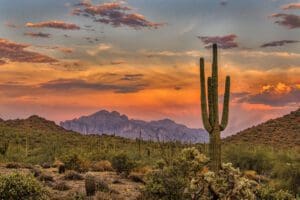 The Sonoran Desert where I live may seem like a hostile environment, with as little as 3-15 inches (7-38 cm) of annual rain and scorching sun that can reach 118 F (47 C). Yet plants, animals, and Native peoples thrive in this environment with resourcefulness and adaptability. The future of supply chain I foresee brings new risks and challenges, along with recognition that doing things the same way will no longer lead to the same success. We must adapt now to survive. What can supply chain leaders learn from the desert to help us chart a path into the future of supply chain and ensure the kind of supply chain resiliency that is characteristic of deserts?
The Sonoran Desert where I live may seem like a hostile environment, with as little as 3-15 inches (7-38 cm) of annual rain and scorching sun that can reach 118 F (47 C). Yet plants, animals, and Native peoples thrive in this environment with resourcefulness and adaptability. The future of supply chain I foresee brings new risks and challenges, along with recognition that doing things the same way will no longer lead to the same success. We must adapt now to survive. What can supply chain leaders learn from the desert to help us chart a path into the future of supply chain and ensure the kind of supply chain resiliency that is characteristic of deserts?
Invest in your ecosystem
The mighty saguaro cactus, icon of the southwest, can grow to be over 70 feet tall (21+ meters) and live to be more than 200 years old, but it grows as little as an inch (2.5 cm) in its first ten years. This slow start to life begins under “nurse” plants, which provide protection from sun and predators. As it matures, saguaros in turn become “nurse” plants for woodpeckers, owls, hawks and songbirds, who all use them for nests.
Just as the saguaro is both nursed by and supports life in its ecosystem, it behooves supply chains to invest in their ecosystems, both suppliers and employees. Ford Motor is investing in domestic battery production and Unilever’s Partner with Purpose program seeks to extend their ecosystem even by building capacity in suppliers in emerging markets. Similarly, only 27% of supply chain leaders say they have the talent they need for their current challenges, but the leaders are those in this minority, who are upskilling the talent they have for the future of supply chain they will face.
Grow when you have your “day in the rain”
While lack of rain may be what comes to mind when you think about the desert, the bigger challenge is its variability. In some years a single storm can dump 50% more rain than in previous years. Plants like the ocotillo may look like dry sticks much of the year but have learned to seize the day when it comes and can sprout leaves within 72 hours after a good rain. Desert plants and animals have all kinds of interesting adaptations like this to capitalize on rain when it does fall.
It may feel like stormy times for supply chain right now, but not all rain is bad. Having a “day in the sun” means being noticed and appreciated, but in the desert we might flip that script and call it a “day in the rain,” given the moisture a storm can bring. So as supply chains are being discussed at the board level and on earnings calls, we are having our moment in the rain. Like the ocotillo we need to take advantage of this rainy moment to grow.
Now is the time to showcase the competitive advantage supply chains bring so we can increase investment needed to deliver those results. But to operate at the board level we need to be able to speak the CFO’s language. Supply chains must be connected and collaborative so all links can align to business strategy and oriented toward a common set of the most important metrics (and not functional metrics that drive siloed behavior). This alignment will drive the results that get the CFO’s attention and reported in the board room and on earnings calls.
Spike up to protect against attack
The desert is famous for spikes and thorns, which make it seem like a threatening place. In fact, this design not only prevents water loss by minimizing surface area for evaporation but also prevents predation by most creatures. Animals that try to take a bite out of a cactus seeking food or moisture will get bitten back by those thorns.
Existing security protections are not enough, so supply chains need to sprout sharp spines to fend off the growing threat from cyber attacks, which the European Union Agency for Cybersecurity (ENISA) estimates will quadruple this year. Attacks can move quickly due to their cascading effect on supply chains, so the risk of damage to the business and to customers is high. As IT and OT (operational technology) converge, when smart factories pass data back and forth to the supply chain, the attack surface grows. ENISA cites the biggest risk from suppliers’ code, but data and internal processes are a risk as well. Heightened investment in cybersecurity is critical to prevent the supply chain from going down.
Shift from just-in-time to just-in-case
Many desert plants are categorized as succulents, which means they are thick and fleshy to absorb water quickly and lose it only slowly and carefully. Given the aridity and variability of rain, they must be able to store water and conserve that hoard carefully. However, just storing water just-in-time isn’t enough; succulents possess additional adaptations to help minimize water loss, such as a special water-efficient form of photosynthesis that also allows them to slow down their metabolism during droughts. These redundant protective mechanisms are essential for survival and mean they will have water just-in-case the skies don’t open again for months.
Supply chains have ridden the wave of lean practices and just-in-time inventory for years, but money saved came at a cost of flexibility and supply chain resiliency, a price which was paid dearly during the pandemic. The decreased appetite for supply chain risk and hunger for greater supply chain resiliency mean inventory strategies must adapt to new ways. The future of supply chain includes a return to dual-sourcing and other practices of redundancy to mitigate risk, but buffers don’t have to explode. Concurrent planning can allow companies to activate capabilities like agility and transparency to prevent stockouts while not building up excess inventory, as global bio-pharmaceutical manufacturer Ipsen has done.
Reduce waste and aim for circular, not linear, designs
The Hohokam thrived for nearly 1,500 years in the Southwest until just before the arrival of the Spanish because they were masters of the desert. In this arid climate they created a fertile agricultural region that supported tens of thousands of people. They wasted nothing, using many parts of plants and animals and engaging in sustainable agriculture by rotating crops and managing soil to replace lost nutrients. But they are most famous for their elaborate irrigation system, one of the most sophisticated ever created and the basis for the canals that still flow through my hometown.
Most supply chains today are linear, starting with raw materials we make into products and then discard at the end of their life. Moving toward a circular supply chain means finding ways to reduce (like Jabil’s multifaceted efforts to use less packaging), reuse (like Cisco’s Takeback and Reuse Program), and recycle (such as Procter & Gamble’s commitment to use all reusable or recyclable packaging by 2030). These kinds of shifts toward a circular economy can save costs and even generate revenue. But more importantly, they increase resilience by mitigating the risks from climate change, which the McKinsey Global Institute predicts will be more significant than the pandemic. Reducing reliance on scarce raw materials, reusing existing materials, and recycling those at end of life alleviates strain on sourcing in a constrained world.
The future of supply chain can be full of blooms
The trends driving the future of supply chain will not be easy to tackle, so now is the time to invest in digital transformation to adapt to new risks, as well as new opportunities. The future we face may seem threatening, so it is wise to look to systems and peoples that have survived under what seem to be hostile conditions. The desert is a master model of resilience. We, too, can learn to bloom in surprising places.
 Polly Mitchell-Guthrie is the VP of Industry Outreach and Thought Leadership at Kinaxis, the leader in empowering people to make confident supply chain decisions. Previously she served in roles as director of Analytical Consulting Services at the University of North Carolina Health Care System, senior manager of the Advanced Analytics Customer Liaison Group in SAS’ Research and Development Division, and Director of the SAS Global Academic Program.
Polly Mitchell-Guthrie is the VP of Industry Outreach and Thought Leadership at Kinaxis, the leader in empowering people to make confident supply chain decisions. Previously she served in roles as director of Analytical Consulting Services at the University of North Carolina Health Care System, senior manager of the Advanced Analytics Customer Liaison Group in SAS’ Research and Development Division, and Director of the SAS Global Academic Program.
Mitchell-Guthrie has an MBA from the Kenan-Flagler Business School of the University of North Carolina at Chapel Hill, where she also received her BA in political science as a Morehead Scholar. She has been active in many roles within INFORMS (the Institute for Operations Research and Management Sciences), including serving as the chair and vice chair of the Analytics Certification Board and secretary of the Analytics Society.
















 Two adjectives that often describe the most successful supply chains are adaptive and resilient. An adaptive supply chain is one that is able to respond quickly to changes and disruption, and the ensuing changes to demand. A resilient supply chain is able to recover quickly from these disruptions. These terms perfectly describe the Asian Paints supply chain.
Two adjectives that often describe the most successful supply chains are adaptive and resilient. An adaptive supply chain is one that is able to respond quickly to changes and disruption, and the ensuing changes to demand. A resilient supply chain is able to recover quickly from these disruptions. These terms perfectly describe the Asian Paints supply chain. If your company’s supply chain survived 2020 and the disruptions of early 2021, it’s safe to say it has passed the supply chain resiliency test.
If your company’s supply chain survived 2020 and the disruptions of early 2021, it’s safe to say it has passed the supply chain resiliency test. As Senior Vice President of Sales and Solutions at
As Senior Vice President of Sales and Solutions at 

